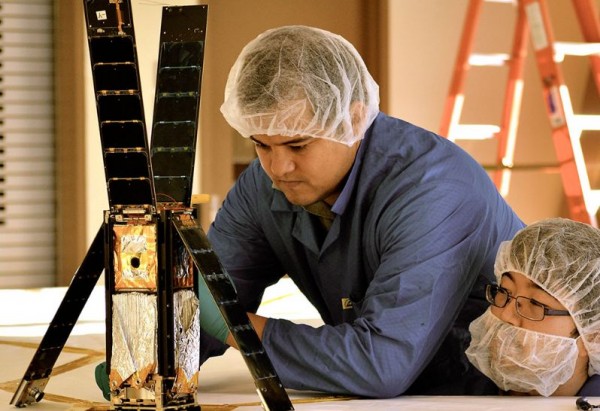LightSail 2 to Test Solar Propulsion -- or Flight by Light -- in Earth Orbit
| Arthur Dominic Villasanta | | Apr 03, 2017 07:06 AM EDT |
(Photo : The Planetary Society) LightSail 2 being prepared for testing.
(Photo : The Planetary Society) LightSail 2 infographic.
LightSail 2, a miniscule solar sail propelled by radiation pressure exerted by sunlight, will be orbited later this year in the second attempt by its makers, The Planetary Society, to prove that solar propulsion is a viable form of spacecraft propulsion.
Solar sails use the sun's energy as a method of propulsion -- flight by light. Light is made of packets of energy called photons. While photons have no mass, a photon traveling as a packet of light has energy and momentum.
Like Us on Facebook
Solar sail spacecraft capture light momentum with large, lightweight mirrored surfaces -- sails. As light reflects off a sail, most of its momentum is transferred, pushing on the sail.
The resulting acceleration is small, but continuous. Unlike chemical rockets that provide short bursts of thrust, solar sails thrust continuously and can reach higher speeds over time.
The three-unit CubeSat the size of a loaf of bread enclosing LightSail 2 will be the payload aboard SpaceX's first commercial Falcon Heavy launch late this year.
LightSail is a citizen-funded project by The Planetary Society, the world's largest non-profit space advocacy group headed by the famous science celebrity Bill Nye (more famously known as Bill Nye the Science Guy).
The Planetary Society will send the CubeSat into low Earth orbit (LEO). The CubeSat will carry a large, reflective sail measuring 32 square meters. The society successfully completed a test flight in June 2015 that paved the way for this second, full-fledged solar sailing demonstration this year.
LightSail 2 will be enclosed within Prox-1, a small satellite developed by the Georgia Institute of Technology (Georgia Tech), to autonomously inspect other spacecraft. Both satellites will be orbited by Falcon Heavy, a new heavy-lift rocket built by SpaceX.
LightSail 2 and Prox-1 will be released into LEO at an altitude of 720 kilometers, high enough to escape most of the planet's atmospheric drag. Prox-1 will eject LightSail 2 into open space.
Once in space, LightSail's solar arrays unfurl, revealing the inside of the spacecraft. Four tape measure-like metal booms slowly unwind from storage, unfolding four triangular Mylar sails. Each sail is just 4.5 microns thick or one-fourth the thickness of an average trash bag.
Three electromagnetic torque rods and a momentum wheel orient LightSail in space. Ground-based lasers will measure the effect of sunlight on the sails. As LightSail breezes around the Earth, its shiny sails will be visible from the ground.
Prox-1 will later rendezvous with LightSail 2 and inspect it. When LightSail 2 unfurls its solar sails, Prox-1 will be nearby to capture images of the historic moment.
LightSail's primary contractor is Ecliptic Enterprises Corporation. The spacecraft has ground stations at Cal Poly San Luis Obispo and Georgia Tech.
Cal Poly provides additional testing and integration support, and the project is managed by Dr. David Spencer of Georgia Tech. Boreal Space and Aquila Space serve as contractors to Ecliptic. LightSail was built by Stellar Exploration, Inc.
The Planetary Society is still accepting donations to the LightSail project.
TagsLightSail 2, solar sail, Sunlight, radiation pressure, The Planetary Society, Photons, CubeSat, Prox-1, Bill Nye the Science Guy
©2015 Chinatopix All rights reserved. Do not reproduce without permission
EDITOR'S PICKS
-

Did the Trump administration just announce plans for a trade war with ‘hostile’ China and Russia?
-

US Senate passes Taiwan travel bill slammed by China
-

As Yan Sihong’s family grieves, here are other Chinese students who went missing abroad. Some have never been found
-

Beijing blasts Western critics who ‘smear China’ with the term sharp power
-

China Envoy Seeks to Defuse Tensions With U.S. as a Trade War Brews
-

Singapore's Deputy PM Provides Bitcoin Vote of Confidence Amid China's Blanket Bans
-

China warns investors over risks in overseas virtual currency trading
-

Chinese government most trustworthy: survey
-

Kashima Antlers On Course For Back-To-Back Titles
MOST POPULAR
LATEST NEWS
Zhou Yongkang: China's Former Security Chief Sentenced to Life in Prison

China's former Chief of the Ministry of Public Security, Zhou Yongkang, has been given a life sentence after he was found guilty of abusing his office, bribery and deliberately ... Full Article
TRENDING STORY

China Pork Prices Expected to Stabilize As The Supplies Recover

Elephone P9000 Smartphone is now on Sale on Amazon India

There's a Big Chance Cliffhangers Won't Still Be Resolved When Grey's Anatomy Season 13 Returns

Supreme Court Ruled on Samsung vs Apple Dispute for Patent Infringement

Microsoft Surface Pro 5 Rumors and Release Date: What is the Latest?














